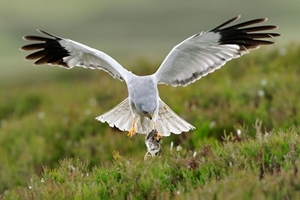 The GWCT condemns the illegal killing of all birds of prey and so the RSPB’s Birdcrime Report, which records 1,344 incidents of the illegal killing of raptors in 15 years, makes for depressing reading. Sadly, the criminal acts of a minority bring gamekeepers into disrepute. By doing so, they cloud the positive conservation work done by game managers across the country – including their work to help raptors.
The GWCT condemns the illegal killing of all birds of prey and so the RSPB’s Birdcrime Report, which records 1,344 incidents of the illegal killing of raptors in 15 years, makes for depressing reading. Sadly, the criminal acts of a minority bring gamekeepers into disrepute. By doing so, they cloud the positive conservation work done by game managers across the country – including their work to help raptors.
However, there is positive news in the RSPB’s report: the year-on-year figures show a continuous decline of 57% in identified ‘bird of prey persecution incidents’ over the past four years. The number of incidents dropped from 137 in 2020 to 59 in 2023, the lowest number of confirmed incidents since 2009 – which was the starting point for the report.
Wildlife crime detracts from all the good work game managers do for conservation. The GWCT is not a shooting organisation, but it supports game management where it complies with the law and delivers a biodiversity net gain. Our research shows that best practice game management can double the number of Red List farmland birds on a landscape scale and improve the density of waders on managed grouse moors to twice that of other moors. A GWCT study published in 2023 showed that species such as curlews, lapwings, golden plovers, oystercatchers and redshanks were all faring better on managed grouse moors. In addition to maintaining healthy numbers of waders, grouse moor management can even provide a surplus of fledglings, potentially aiding species recovery. This provides a lifeline for many of the UK’s most threatened species, including birds of prey.
A good example is the hen harrier, one of the species referred to in the RSPB report. Thanks to Defra’s Hen Harrier Recovery Plan, which works with gamekeepers to relocate broods when there are too many for a moor to sustain, the species has reached a 200-year high within five years.
Given the rate of increase, it is possible that Special Protection Areas (SPAs) will achieve an optimum population level of hen harriers in the near future, as long as weather conditions, predation levels and availability of food are favourable at breeding time. Indeed, the overall population of hen harriers across England could reach its target in the foreseeable future.
This does not detract from the fact that the illegal killing of hen harriers is sometimes associated with grouse moor management. That is why the Hen Harrier Action Plan was created and why the grouse moor management community has worked tirelessly with Natural England and others to work out a solution to the conflict in the form of the brood management trial. It shows that progress can be made in reaching a solution to this complex, polarised and multi-layered conflict.
 There is good news in Scotland, too. This year, the Raptor Transect Survey Project, which is administered by the GWCT for Scotland’s Regional Moorland Groups, showed an increase in golden eagle records, from 26 to 59 – more than double the number recorded in 2023. This iconic species is now on the Green List as it has exceeded the national target for favourable conservation status set by NatureScot.
There is good news in Scotland, too. This year, the Raptor Transect Survey Project, which is administered by the GWCT for Scotland’s Regional Moorland Groups, showed an increase in golden eagle records, from 26 to 59 – more than double the number recorded in 2023. This iconic species is now on the Green List as it has exceeded the national target for favourable conservation status set by NatureScot.
Red kite records also increased from 63 to 86, particularly in the Angus Glens and Tayside areas. Hen harrier records increased from 4 to 12, and peregrines by a similar number.
The continuing cooperation and support of game managers, farmers and estates for this initiative demonstrates the vital contribution of moorland and its sustainable management to Scotland’s biodiversity.
While reports like the RSPB’s Birdcrime 2023 rightly raise the issue of wildlife crime, there is no effort to communicate the whole picture, contextualise the figures or highlight the positive trends demonstrated. This approach presents a barrier to effective conflict resolution and conservation measures, such as those demonstrated by the collaborative hen harrier recovery strategy. Wildlife crime is still a problem, and we must not shy away from that fact. But we must also recognise how the majority of game managers contribute to nature recovery and work together to find a sustainable framework for raptor conservation.
Photo credit: Laurie Campbell